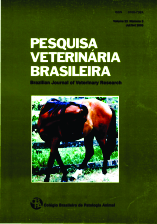 |
|
|
|
Year 2003 - Volume 23, Number 3
|

|
Natural and experimental poisoning by amitraz in horses and donkey: Clinical aspects, 23(3):105-118
|
ABSTRACT.- Duarte M.D., Peixoto P. V., Bezerra P. S., Oliveira K. D., Loretti A. P. & Tokarnia C.H. 2003. [Natural and experimental poisoning by amitraz in horses and donkey: Clinical aspects.) Intoxicações natural e experimental por amitraz em eqüídeos: aspectos clínicos. Pesquisa Veterinária Brasileira 23(3):105-118. Hospital Veterinário, Setor Grandes Animais, Universidade Federal Rural do Rio de Janeiro, Seropédica. RJ 23835-000, Brazil. E-mail: marcos @webcem.com.br
Poisoning by amitraz was experimentally reproduced in 17 horses and a donkey. First symptoms were observed between 15 min. and 2 h 5 min. after oral administration, and between 6 h 28 min. and 8 h 38 min. after spraying with amitraz. The course of poisoning after oral administration was 4 to 9 days, and after spraying 5 to 6 days. Death of experimental animais occurred only after oral administration. One animal was euthanized after spraying. Doses of 5.5 mg/kg (1 administration), 5.8 mg/kg (2 administrations) and doses which varied between 7.2 and 36.4 mg/kg (5 administrations) were used when amitraz was given by mouth, ali causing symptoms of poisoning. When the administration of amitraz was by spraying, poisoning was reproduced with solutions of 0.1 and 0.2 %. Regarding the nervous system, the main signs observed were recumbency, somnolence, palpebral and auriculár ptosis, difficulties in apprehension, chewing and swallowing of food, dragging of the hooves, exposure of the penis, diminished or absent cutaneous sensibility, instability, abduction of the legs, lowering of the head, incoordination, jawning, labial flacity, exposure of the tongue, crossing of the legs when walking, diminished postural response after crossing or abducting the legs, diminished/absent reflex of the upper lip, palatal, tongue, flexor and swallowing reflex, diminished auricular, palpebral and menace reflex. The ambulatory response was diminished when tested by walking in circles of small radius. Regarding the digestive system, the signs were mainly intestinal hypomotility/atony, edema of the lips, abdominal distention, frequente lying down and standing up, rolling on the ground, looking at the flancs, groaning and impaction of the large bowel. Regarding the circulatory system, the main clinical signs were tachycardia, increase of the refilling time of capillaries, congested mucosa and splitting of the cardiac sounds. Regarding the respiratory system, stridor, tachypnoea, dyspnoea, nasal discharge, bradypnoea and abdominal respiration was observed. Beside these signs, there were alterations of the general condition, as apathy and hypothermia. Ali natural cases occurred after spraying with amitraz. First symptoms were seen 2 to 3 days after the application of amitraz. The course was 6, 7 and 17 days. One animal showed mainly the nervous signs as seen in the experiments, with exception of the signs of crossing the legs when walking, yawning and exposure of the penis. Another animal had only digestive symptoms as rolling, pawing, intestinal hypomotility/atony and impaction of the large bowel. A third animal initially showed digestive symptoms characterized by pawing, rolling, intestinal atony and impaction of the Iarge bowel, followed by laminitis; in the final stage this animal showed severe nervous signs as pressing the head against obstacles, incoordination with crossing the legs when walking and reluctance to move. Possible Iocation of lesions in the nervous system according to the clinical signs are suggested. |
| |
|
|
| |
|
 |